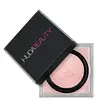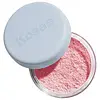What's inside
What's inside
 Key Ingredients
Key Ingredients

 Benefits
Benefits

No benefits
 Concerns
Concerns

 Ingredients Side-by-side
Ingredients Side-by-side

Talc
AbrasiveSynthetic Fluorphlogopite
Silica
AbrasiveDimethicone
EmollientNylon-12
Caprylyl Glycol
EmollientPentylene Glycol
Skin ConditioningOryza Sativa Starch
AbsorbentPhenyl Trimethicone
Skin ConditioningSodium Dehydroacetate
PreservativeOctyldodecyl Stearoyl Stearate
EmollientDiisostearyl Malate
EmollientParfum
MaskingTocopheryl Acetate
AntioxidantBenzyl Salicylate
PerfumingSorbitan Sesquioleate
EmulsifyingHexyl Cinnamal
PerfumingLinalool
PerfumingCoumarin
PerfumingHydroxycitronellal
PerfumingBenzyl Benzoate
AntimicrobialIron Oxides
Ultramarines
CI 19140
Cosmetic ColorantCI 77499
Cosmetic ColorantCI 73360
Cosmetic ColorantTalc, Synthetic Fluorphlogopite, Silica, Dimethicone, Nylon-12, Caprylyl Glycol, Pentylene Glycol, Oryza Sativa Starch, Phenyl Trimethicone, Sodium Dehydroacetate, Octyldodecyl Stearoyl Stearate, Diisostearyl Malate, Parfum, Tocopheryl Acetate, Benzyl Salicylate, Sorbitan Sesquioleate, Hexyl Cinnamal, Linalool, Coumarin, Hydroxycitronellal, Benzyl Benzoate, Iron Oxides, Ultramarines, CI 19140, CI 77499, CI 73360
Mica
Cosmetic ColorantSilica
AbrasiveIsodecyl Neopentanoate
EmollientBambusa Arundinacea Stem Extract
Skin ConditioningBoron Nitride
AbsorbentHydrogenated Vegetable Oil
EmollientC15-19 Alkane
SolventHelianthus Annuus Seed Oil
EmollientTocopherol
AntioxidantCitric Acid
BufferingGlyceryl Undecylenate
EmollientGlyceryl Caprylate
EmollientPentylene Glycol
Skin ConditioningSodium Dehydroacetate
PreservativeCI 19140
Cosmetic ColorantCI 45410
Cosmetic ColorantCI 15850
Cosmetic Colorant
 Reviews
Reviews

Ingredients Explained
These ingredients are found in both products.
Ingredients higher up in an ingredient list are typically present in a larger amount.
CI 19140 is also known as Tartrazine. Tartrazine is a synthetic dye used in cosmetics, foods, and medicine to add a yellow color.
Tartrazine is created from petroleum and is water-soluble.
Some people may experience allergies from this dye, especially asthmatics and those with an aspirin intolerance.
Learn more about CI 19140Pentylene glycol is typically used within a product to thicken it. It also adds a smooth, soft, and moisturizing feel to the product. It is naturally found in plants such as sugar beets.
The hydrophilic trait of Pentylene Glycol makes it a humectant. As a humectant, Pentylene Glycol helps draw moisture from the air to your skin. This can help keep your skin hydrated.
This property also makes Pentylene Glycol a great texture enhancer. It can also help thicken or stabilize a product.
Pentylene Glycol also acts as a mild preservative and helps to keep a product microbe-free.
Some people may experience mild eye and skin irritation from Pentylene Glycol. We always recommend speaking with a professional about using this ingredient in your routine.
Pentylene Glycol has a low molecular weight and is part of the 1,2-glycol family.
Learn more about Pentylene GlycolSilica, also known as silicon dioxide, is a naturally occurring mineral. It is used as a fine, spherical, and porous powder in cosmetics.
Though it has exfoliant properties, the function of silica varies depending on the product.
The unique structure of silica enhances the spreadability and adds smoothness, making it a great texture enhancer.
It is also used as an active carrier, emulsifier, and mattifier due to its ability to absorb excess oil.
In some products, tiny microneedles called spicules are made from silica or hydrolyzed sponge. When you rub them in, they lightly polish away dead skin layers and enhance the penetration of active ingredients.
Learn more about SilicaThis ingredient is a preservative with antimicrobial properties. It is the sodium salt of dehydroacetic acid.
It is especially effective at preventing bacterial and fungal growth in low concentrations.